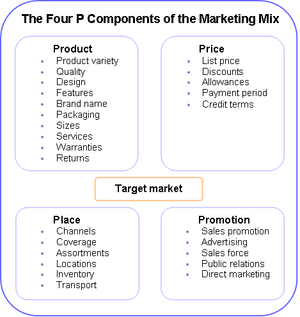International marketing mix strategy
| International marketing mix strategy |
|---|
| See also |
International marketing mix strategy involves use of different marketing instruments to achieve positive financial results by company operating on international or global markets. These instruments include: product, price, distribution and promotion. International marketing mix strategy should take into account legal and socio-cultural circumstances in every country to which it is directed.
Main types of international marketing strategy
On international market marketing mix has three varieties:
- Global marketing mix strategy - is based on the assumption that on the international market there is so called global consumer with similar needs and preferences. Using this approach, on foreign markets companies apply identical marketing instruments and their combinations, there is no different instruments adapted for social and cultural environment in those countries,
- National marketing mix strategy or multinational strategy - for each country company applies a separate marketing strategy adapted to specific needs and preferences of customers, their customs and traditions,
- Hybrid marketing mix strategy - involves standardization of one or more marketing instruments and at the same time adjusting others to the characteristics and conditions prevailing on the particular national market (customs, traditions, regulations, etc.,).
Different product strategies used in international markets
Product policy on the international market includes three strategies:
- Product standardization - company introduces unchanged product on the foreign market. Such action makes sense when the product due to its nature, has similar utility for customers on various markets. The use of this strategy is comfortable and not very expensive. Example of companies using this strategy is IKEA.
- Product adaptation - involves adjustment of the product and its properties to the conditions prevailing on the particular market. This includes packaging, size, symbols (depending on the culture prevailing in the country concerned), colour. Adaptation of the product requires large amount of capital and experience.
- Gradual changes in the product - used in situation where there is no danger of the emergence of competition.
Pricing policies in international marketing mix
Pricing involves the problem of price management on an international scale. There are two basic points of view:
- usually, company introduce separate pricing policies on foreign markets (due to differences of wealth, competition, etc.),
- development of modern communication technology makes distant markets more similar to each other, which makes it harder to lead a separate pricing policy at home and abroad. In this case, the company carries out a global pricing strategy, when the processes of internationalization blur the differences between the various markets.
Distribution policy in international markets
On the international market distribution activities are related to the offering on the market of products in an appropriate form, place and time. The activities must, however, be adapted to other instruments of the marketing mix and change along with them. The main goal of distribution policy is to overcome spatial, temporary and ownership barriers to distribution separating manufacturer and the final customer. International logistics plays major role in international sales and production activities.
Promotion policy as a marketing mix instrument abroad
Promotion policy involves transferring information to new potential buyers about the company, its products in order to make them to buy these products. Selection and use of the instruments needed to achieve these objectives depends on factors such as:
- objective of promotion on the international market,
- financial resources and experience in foreign markets,
- provisions of the law which regulate promotional activities in each country,
- cultural factors - e.g. language, habits, religion, symbols, associations related to the colour,
- attitude to foreign products,
- competition on the foreign market,
- the company may take similar actions as experienced competitors or, if it is lacking in resources, cooperate with the participants in the distribution channel and jointly carry out promotion,
- the nature and quality of the product,
- type of the customer.
See also:
References
- Bradley, F. (2005). International marketing strategy. Pearson Education.
- Doole, I., & Lowe, R. (2008). International marketing strategy: analysis, development and implementation. Cengage Learning EMEA.
- In, G. S. (1989). Global strategy... in a world of nations?.
- Jain, S. C. (1989). Standardization of international marketing strategy: some research hypotheses. The Journal of Marketing, 70-79.
- Quelch, J. A., & Klein, L. R. (1996). The Internet and international marketing. MIT Sloan Management Review, 37(3), 60.
